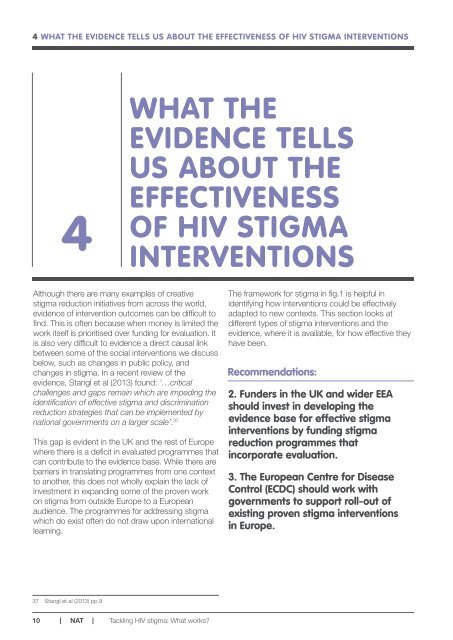Tackling HIV Stigma What works?
Jun_16_Tackling_HIV_Stigma
Jun_16_Tackling_HIV_Stigma
Create successful ePaper yourself
Turn your PDF publications into a flip-book with our unique Google optimized e-Paper software.
4 WHAT THE EVIDENCE TELLS US ABOUT THE EFFECTIVENESS OF <strong>HIV</strong> STIGMA INTERVENTIONS<br />
4<br />
WHAT THE<br />
EVIDENCE TELLS<br />
US ABOUT THE<br />
EFFECTIVENESS<br />
OF <strong>HIV</strong> STIGMA<br />
INTERVENTIONS<br />
Although there are many examples of creative<br />
stigma reduction initiatives from across the world,<br />
evidence of intervention outcomes can be difficult to<br />
find. This is often because when money is limited the<br />
work itself is prioritised over funding for evaluation. It<br />
is also very difficult to evidence a direct causal link<br />
between some of the social interventions we discuss<br />
below, such as changes in public policy, and<br />
changes in stigma. In a recent review of the<br />
evidence, Stangl et al (2013) found: ‘…critical<br />
challenges and gaps remain which are impeding the<br />
identification of effective stigma and discrimination<br />
reduction strategies that can be implemented by<br />
national governments on a larger scale’. 37<br />
This gap is evident in the UK and the rest of Europe<br />
where there is a deficit in evaluated programmes that<br />
can contribute to the evidence base. While there are<br />
barriers in translating programmes from one context<br />
to another, this does not wholly explain the lack of<br />
investment in expanding some of the proven work<br />
on stigma from outside Europe to a European<br />
audience. The programmes for addressing stigma<br />
which do exist often do not draw upon international<br />
learning.<br />
The framework for stigma in fig.1 is helpful in<br />
identifying how interventions could be effectively<br />
adapted to new contexts. This section looks at<br />
different types of stigma interventions and the<br />
evidence, where it is available, for how effective they<br />
have been.<br />
Recommendations:<br />
2. Funders in the UK and wider EEA<br />
should invest in developing the<br />
evidence base for effective stigma<br />
interventions by funding stigma<br />
reduction programmes that<br />
incorporate evaluation.<br />
3. The European Centre for Disease<br />
Control (ECDC) should work with<br />
governments to support roll-out of<br />
existing proven stigma interventions<br />
in Europe.<br />
37 Stangl et al (2013) pp.9<br />
10 NAT<br />
<strong>Tackling</strong> <strong>HIV</strong> stigma: <strong>What</strong> <strong>works</strong>?


